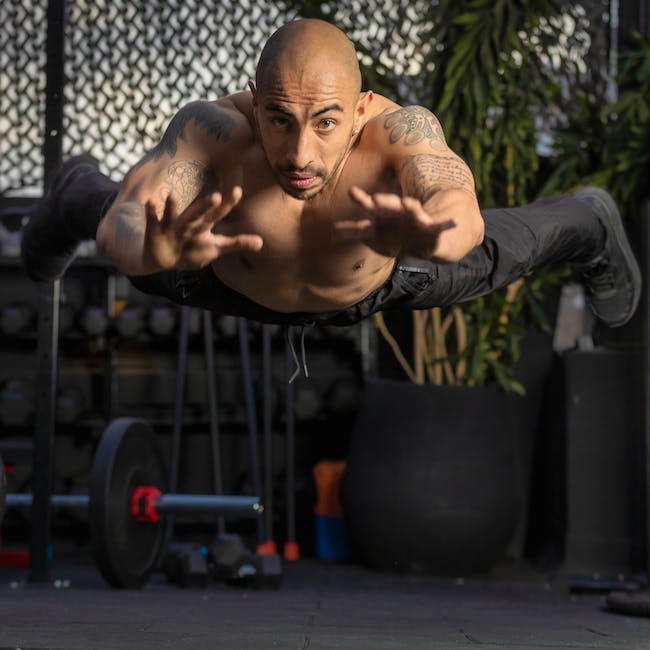Ladies and gentlemen, gather round, because I’ve got some news for ya. If you want to achieve the body of a Greek god or goddess, you’re gonna have to lift some heavy sh**. And by heavy sh**, I mean deadlifts.
Now, I know what some of you are thinking. “But I don’t want to hurt myself!” “But I don’t want to look stupid!” “But I don’t want to fart in front of everyone!” Fear not my friends, for I am here to guide you through the treacherous world of deadlifts – safely, confidently, and flatulence-free.
So grab your chalk, your weightlifting belt, and your sense of humor, because we’re about to dive into the world of safe deadlifts for beginners. Let’s get fit, let’s get strong, and most importantly, let’s get a solid grip on the barbell.
Contents
- 1 1. Understanding the Basics of Deadlifting: A Comprehensive Introduction for Beginners
- 2 2. The Importance of Proper Form: Key Steps for Safe Deadlifts
- 3 3. Common Mistakes to Avoid: Tips to Preventing Injuries during Deadlift Workouts
- 4 4. Gradual Progression: Essential Strategies for Building Strength without Risking Injury
- 5 5. Incorporating Deadlifts into your Fitness Routine: Best Practices for Beginners
- 6 Don’t Be a Dummy, Deadlift Safely!
1. Understanding the Basics of Deadlifting: A Comprehensive Introduction for Beginners
The Anatomy of a Deadlift
Before you start yanking those weights off the ground like a caveman, it’s important to understand the proper form and technique. The deadlift is a compound exercise that involves several muscle groups, including your hamstrings, glutes, lower back, and traps. Here’s a breakdown of the basic steps:
- Grip the bar: Grab the bar with an overhand grip, slightly wider than shoulder-width apart.
- Set your feet: Plant your feet firmly on the ground, shoulder-width apart, with the bar directly over your shoelaces.
- Bend your knees: Keeping your back straight, lower your hips until your shins are perpendicular to the floor.
- Lift the bar: Drive through your heels and stand up, lifting the bar with your legs and hips.
- Lower the bar: Reverse the motion, lowering the bar back to the ground by bending your knees and hip.
The Benefits of Deadlifting
Deadlifting isn’t just about pumping up your muscles and showing off your gains at the gym. It’s also an incredibly functional exercise that can help improve your overall strength and health. Here are a few key benefits:
- Builds overall strength: Deadlifting is one of the best exercises for building overall strength and power, as it targets multiple muscle groups at once.
- Improves posture: By working your lower back, hips, and glutes, deadlifting can help improve your posture and reduce lower back pain.
- Burns calories: Deadlifting is a high-intensity exercise that can help you burn calories and boost your metabolism.
- Makes you feel like a badass: Let’s be real, there’s nothing quite like the feeling of lifting a heavy bar off the ground like a boss.
Common Deadlift Mistakes to Avoid
While deadlifting may seem simple enough, there are a few common mistakes that beginners often make. Here are a few things to watch out for:
- Rounding your back: Keeping your back straight is crucial during a deadlift. Rounding your back can put unnecessary strain on your spine and increase your risk of injury.
- Lifting with your back: Remember, the deadlift is a leg exercise. Make sure you’re initiating the lift with your legs and hips, rather than pulling with your back.
- Using too much weight: It’s important to start with a weight that you can handle with proper form. Using too much weight can lead to injury and set you back in your training.
- Skipping the warm-up: Deadlifting is a demanding exercise that puts a lot of stress on your muscles and joints. Make sure to warm up properly to reduce your risk of injury.

2. The Importance of Proper Form: Key Steps for Safe Deadlifts
Deadlifting is a great way to build strength and muscle mass. However, if done incorrectly, it can lead to serious injuries. This is why proper form is crucial to ensure safe and effective deadlifts. Here are some key steps to help you master your deadlift form and avoid becoming a meme in the gym.
1. Set up your stance: Begin by standing with your feet hip-width apart, toes pointing forward, and the barbell over the midfoot. You can adjust your stance based on your body type or preference, but remember to keep your feet flat on the ground and your weight centered over the midfoot.
2. Engage your core: Before you lift the bar, take a deep breath and brace your core muscles. This will help you maintain a stable spine throughout the lift and prevent any unnecessary arching or rounding.
3. Pull up, not forward: As you lift the bar, think of driving your hips forward and standing up straight. Avoid pulling the bar up with your back, as this can strain your spine and increase the risk of injury. Remember to keep the bar close to your body and use your legs to power the movement.
Remember, deadlifting is not a competition to see who can lift the most weight with the worst form. Be patient, take your time, and prioritize your safety. With the right approach, you can get stronger, build muscle, and impress your gym crushes without ending up on YouTube fails.
3. Common Mistakes to Avoid: Tips to Preventing Injuries during Deadlift Workouts
Deadlift workouts are a power-packed exercise that is essential for any fitness enthusiast. Not only does it build your legs, back, and booty, but it also helps you gain strength and stability. However, if you’re not careful, you can end up injured, and no one wants that! So, to ensure you stay safe and injury-free, we’ve compiled a list of common mistakes you should avoid. These mistakes might seem trivial, but trust me, they can pack a punch! So, let’s get started.
- Don’t Round Your Back, Bro: The mistake of rounding your back is like asking for an injury. Not only does it hurt your back, but it also puts a lot of pressure on your spine. So, to avoid any unwanted injuries, always keep your back straight while lifting.
- Don’t Forget to Engage Your Core: While deadlifting, your core plays a crucial role in supporting your spine and maintaining a good posture. So, don’t forget to keep your abdomen tight and hold in that belly button!
- Don’t Lift too Fast: Deadlifts are not a race to the finish line. Slow and steady wins the race here. Lifting too fast can put a strain on your muscles and cause injury. So, take your time and lift with control.
Remember, Deadlifts are not just for those gym junkies; they are a fundamental exercise for anyone looking to gain strength and stability. However, these common mistakes can hinder your progress and leave you injured. So, follow these tips and avoid the mistakes, and your deadlifts will be smooth sailing!
4. Gradual Progression: Essential Strategies for Building Strength without Risking Injury
Are you tired of going hard in the gym only to end up with an injury that sets you back for weeks? Fear not, because I have some essential strategies for building strength without risking injury.
First and foremost, start off slow and steady. Don’t jump into lifting heavyweight right off the bat. Begin with lightweights and focus on form to ensure that you’re not straining any muscles or joints.
Another important strategy is to gradually increase your weightload over time. Remember, Rome wasn’t built in a day! So, grab a pen and paper and plan out your long-term goals. By doing this, you’ll be able to monitor your progress and make changes according to your needs.
Finally, don’t skip over rest days! Taking a break from the gym will not only improve your strength but also reduces the risk of injury. So, take a day off and treat yourself to some ice cream or pizza – I promise, it won’t hurt your gains!
Remember, building strength takes time, patience, and consistency. So, start slow, be patient, and don’t forget to rest! Happy lifting!
5. Incorporating Deadlifts into your Fitness Routine: Best Practices for Beginners
So, you’ve decided to incorporate deadlifts into your fitness routine, huh? Well, well, well – aren’t we fancy? Don’t worry, newbie, I’m here to guide you through the best practices for beginners. Let’s get started.
First things first, make sure you have the proper equipment. Don’t try to lift with those ratty old sneakers that you’ve had since high school. Invest in some sturdy, flat-soled shoes to help you maintain proper form. And don’t forget about the belt – it’s not just a fashion statement, it actually helps support your lower back. Embrace the accessorizing opportunity and get yourself a cool, heavy-duty lifting belt.
Next up, warm-up! Deadlifts are no joke, and you don’t want to pull a muscle and wind up looking like a sad, limping puppy dog. Spend some time stretching your hamstrings, quads, and glutes. You can also add in some bodyweight squats and lunges to really get the blood flowing. And hey, while you’re at it, why not throw in a few arm circles and a quick dance break? Deadlifts may be serious business, but that doesn’t mean you can’t have fun with it.
Lastly, form is key. You want to make sure you’re lifting with your legs and not just your back. A proper deadlift involves hinging at the hips and pushing through your heels to lift the weight. Keep your chest up, shoulders back, and core engaged. And don’t forget to exhale at the top! Trust me, you don’t want to accidentally hold your breath and pass out mid-lift. That would be a whole different kind of workout.
Now go forth, my little gym-goer, and deadlift with confidence. Just don’t forget to thank me when you’re crushing those weights and feeling like a total badass.
Don’t Be a Dummy, Deadlift Safely!
So, there you have it folks! You can now confidently approach the bar and lift some weight without worrying about injuring yourself. Remember, the deadlift is a great exercise to strengthen your entire body, but always prioritize safety over ego. Use proper form, start with light weights, and progress slowly. And if anyone tries to tell you that deadlifts are dangerous, just tell them “Hey, I’m not stupid…I deadlift safely.”








Leave A Comment